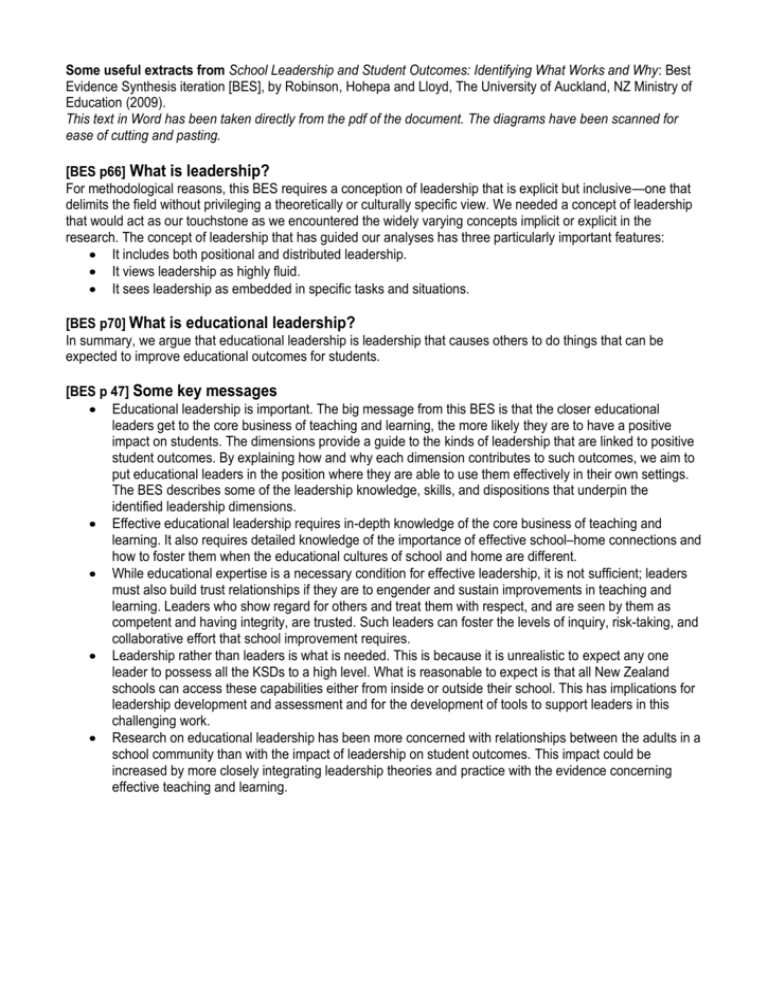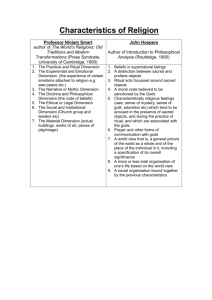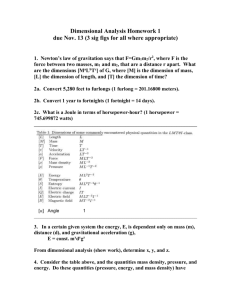Extracts and diagrams from BESLeadership
advertisement

Some useful extracts from School Leadership and Student Outcomes: Identifying What Works and Why: Best Evidence Synthesis iteration [BES], by Robinson, Hohepa and Lloyd, The University of Auckland, NZ Ministry of Education (2009). This text in Word has been taken directly from the pdf of the document. The diagrams have been scanned for ease of cutting and pasting. [BES p66] What is leadership? For methodological reasons, this BES requires a conception of leadership that is explicit but inclusive—one that delimits the field without privileging a theoretically or culturally specific view. We needed a concept of leadership that would act as our touchstone as we encountered the widely varying concepts implicit or explicit in the research. The concept of leadership that has guided our analyses has three particularly important features: It includes both positional and distributed leadership. It views leadership as highly fluid. It sees leadership as embedded in specific tasks and situations. [BES p70] What is educational leadership? In summary, we argue that educational leadership is leadership that causes others to do things that can be expected to improve educational outcomes for students. [BES p 47] Some key messages Educational leadership is important. The big message from this BES is that the closer educational leaders get to the core business of teaching and learning, the more likely they are to have a positive impact on students. The dimensions provide a guide to the kinds of leadership that are linked to positive student outcomes. By explaining how and why each dimension contributes to such outcomes, we aim to put educational leaders in the position where they are able to use them effectively in their own settings. The BES describes some of the leadership knowledge, skills, and dispositions that underpin the identified leadership dimensions. Effective educational leadership requires in-depth knowledge of the core business of teaching and learning. It also requires detailed knowledge of the importance of effective school–home connections and how to foster them when the educational cultures of school and home are different. While educational expertise is a necessary condition for effective leadership, it is not sufficient; leaders must also build trust relationships if they are to engender and sustain improvements in teaching and learning. Leaders who show regard for others and treat them with respect, and are seen by them as competent and having integrity, are trusted. Such leaders can foster the levels of inquiry, risk-taking, and collaborative effort that school improvement requires. Leadership rather than leaders is what is needed. This is because it is unrealistic to expect any one leader to possess all the KSDs to a high level. What is reasonable to expect is that all New Zealand schools can access these capabilities either from inside or outside their school. This has implications for leadership development and assessment and for the development of tools to support leaders in this challenging work. Research on educational leadership has been more concerned with relationships between the adults in a school community than with the impact of leadership on student outcomes. This impact could be increased by more closely integrating leadership theories and practice with the evidence concerning effective teaching and learning. BES Page 39 BES p39 [BES p40-44] The leadership dimensions from direct evidence 1. Establishing goals and expectations: Whaia te iti kahurangi This dimension is about the exercise of leadership through the setting and communicating of goals for teacher and student learning. The mean effect size for this dimension (.42) was second equal highest. An effect of this magnitude can be interpreted as moderate and educationally significant. Effective goal setting requires that leaders: establish the importance of the goals; ensure that the goals are clear; develop staff commitment to the goals. Leaders establish the importance of goals by communicating how they are linked to pedagogical, philosophical, and moral purposes. They gain agreement that the goals are realistic and win collective commitment to achieving them. Establishing goals came through as particularly pertinent to Màori-medium settings. This is because important goals have clear linkages to wider philosophical and cultural purposes, particularly to Màori language and cultural regeneration. It is clear that relationships are an important aspect of this dimension because leaders in high performing schools tend to give priority to communicating goals and expectations, informing the community of academic accomplishments, and recognising academic achievement. There is also evidence that suggests that the level of staff consensus on school goals is a significant discriminator between otherwise similar, high- and low-performing schools. To implement leadership practices linked to this dimension, leaders need to have an understanding of why goal setting is important and some knowledge of how goal setting works. Figure 4 outlines the conditions required, processes involved, and consequences of effective goal setting. There is evidence that the content of goals may be as important as the process of goal setting: leaders need to know what goals to set as well as how to set them. In high-performing schools, there was a stronger emphasis on academic goals, though this was not incompatible with a further emphasis on social goals. 2. Resourcing strategically: Mà te huruhuru ka rere te manu Leadership is also exercised through obtaining and allocating material, intellectual, and human resources. As the word ‘strategically’ signals, this dimension is not about securing resources per se but about securing and allocating resources that are aligned to pedagogical purposes. At all levels of the education system, leaders play a vital role in working with teachers to identify and develop appropriate teaching and learning resources and in ensuring that these are readily available. The mean effect size for this dimension indicates that it has a small indirect impact on student outcomes. Identifying and obtaining assessment resources that are pedagogically and philosophically aligned to valued goals is a particular challenge for leadership in Màori-medium schools. For example, there are relatively few standardised assessment procedures available in te reo Màori and limited access to professional learning opportunities focused on Màori-medium assessment. When identifying and obtaining resources, leaders in high-performing schools: use clear criteria that are aligned to pedagogical and philosophical purposes; ensure sustained funding for pedagogical priorities. Leaders use clear criteria to identify and obtain resources that are aligned to pedagogical and philosophical purposes. They also strive to ensure sustained funding for pedagogical purposes by, for example, prioritising or rationalising expenditure. Alignment of resources extends to recruiting appropriate staff and developing the kinds of expertise needed to achieve important goals. 3. Planning, coordinating, and evaluating teaching and the curriculum: Kia pai te whakatere i te waka This dimension is about leaders’ emphasis on improving the quality of teaching and the curriculum. The mean effect size obtained was the same as for Dimension 1, which should be interpreted as meaning that this set of leadership practices has a moderate and educationally significant impact on student outcomes. Leaders in highperforming schools are distinguished from their counterparts in otherwise similar, low-performing schools by their personal involvement in planning, coordinating, and evaluating teaching and teachers. When planning, coordinating, and evaluating teaching and the curriculum, leaders in high performing schools: promote collegial discussions of teaching and how it impacts on student achievement; provide active oversight and coordination of the teaching programme; observe in classrooms and provide feedback that teachers describe as useful; ensure systematic monitoring of student progress and use of assessment results for programme improvement. 4. Promoting and participating in teacher learning and development: Ko te waka màtauranga, he waka eke noa Of all the dimensions derived from the meta-analysis, this dimension produced the largest estimated effect size. This means that this set of leadership practices has a large, very educationally significant effect on student outcomes. The practices involved in this dimension include participation in, as well as promotion of, formal and informal opportunities for teacher learning and development. Leaders can participate in teacher professional learning as leaders, as learners, or as both. There are important differences on this dimension between the practices of leaders in otherwise similar, highand low-performing schools. For instance, staff in high-performing schools report that their leaders work directly with teachers or departmental heads to plan, coordinate, and evaluate teachers and teaching. Such leaders are also more likely to provide evaluations that teachers find useful—and to ensure that student progress is monitored and assessment results used to improve teaching. Leaders who are actively involved in professional learning have a deeper appreciation of the conditions required to achieve and sustain improvements in student learning. This means they can discuss necessary changes with teachers and support them by making appropriate adjustments to class organisation, resourcing, and assessment procedures. Leadership promotes teacher learning via communities that are focused on improving student success. To establish such communities, leaders may need to challenge or change cultures that are not focused on collegial discussion of the relationship between what is taught and what is learned. Associated with effective professional communities is a strong sense of collective responsibility and accountability for student achievement and well-being. Improved student outcomes strengthen teachers’ sense of efficacy and collective responsibility and this, in turn, encourages them to greater effort and persistence. The result is a virtuous circle, in which teacher confidence and competence and student success are mutually enhancing. When promoting and participating in teacher learning and development, leaders in high performing schools: ensure an intensive focus on the teaching–learning relationship; promote collective responsibility and accountability for student achievement and well-being; provide useful advice about how to solve teaching problems. 5. Ensuring an orderly and supportive environment: Ka tika à muri, ka tika à mua Leadership can facilitate the achievement of important academic and social goals by creating an environment that is conducive to success. An orderly environment makes it possible for teachers to focus on teaching and students to focus on learning. This dimension, derived from forward mapping studies, has a small mean effect size. The indicators for this dimension include a focus on cultural understanding and a respect for difference; provision of a safe, orderly environment and a clear discipline code; and minimal interruption to teaching time. Other indicators include protection of staff from unreasonable parental and official pressures and early and effective conflict resolution. The findings suggest that leaders of effective schools succeed in establishing a safe and supportive environment by means of clear and consistently enforced social expectations and discipline codes. In such an environment, staff conflict is quickly and effectively addressed. One study found that the principal’s ability to identify and resolve conflict—rather than allow it to fester—was strongly associated with student achievement in mathematics. Differences in teacher and principal perceptions of the latter’s ability to identify and resolve conflict was also a significant discriminator of high- and low-performing schools. When ensuring an orderly and supportive environment, leaders in high-performing schools: protect teaching time; ensure consistent discipline routines; identify and resolve conflicts quickly and effectively. The dimensions from indirect evidence 6. Creating educationally powerful connections: Ehara taku toa i te toa takitahi engari he toa takitini This dimension is about creating connections—between individuals, organisations, and cultures—that have an explicit focus on student learning. Leaders can encourage such connections by ensuring closer pedagogical and philosophical matches between what students bring to school and what happens to them in the classroom. This might involve finding out more about diverse students’ experiences in the school as a first step to improving teaching and learning. It might involve making changes to the school’s collective culture to connect more effectively with families/whànau and the community. Pedagogical matches are facilitated when students experience continuity of content and practice as they move between programmes and classes. Leaders can also play a role in ensuring that students experience continuity as they move from one educational setting to another. While relationships are embedded in every dimension, they are particularly significant when it comes to creating connections. Relationships can be a key to developing knowledge of, and respect for, individual and cultural identities. Relationships between adults need to be developed in ways that promote the achievement and wellbeing of students. Leaders can create educationally powerful connections by: establishing continuities between student identities and school practices; developing continuities and coherence across teaching programmes; ensuring effective transitions from one educational setting to another. 7. Engaging in constructive problem talk: He kaha ki te whakahaere i ngà raruraru This dimension is about the ability to name, describe, and analyse problems in ways that reveal possibilities for school-based change. Leaders who engage in constructive problem talk describe problems in ways that invite ownership and commitment and can respectfully examine how they and others might be contributing to a problem. A prerequisite for engaging is the ability to inquire into the theory that underpins the practice that needs changing. Theories of action are powerful both because they explain teachers’ actions and because they shape how change messages are interpreted. By engaging teachers’ theories of action, leaders help teachers make their beliefs explicit and help them evaluate those beliefs in relation to the proposed alternative theory. Successful theory engagement requires a deep understanding of the factors that sustain current practice and, therefore, of the challenges involved in changing it. The New Zealand research literature that we reviewed provides strong evidence of the positive consequences of theory engagement for both adult relationships and student outcomes. Leaders who engage in constructive problem talk: discover the reasons why teachers do the things they seek to change (engage teachers’ theories of action); lead discussions of the relative merits of current and alternative practice. 8. Selecting, developing, and using smart tools: Ngà tapu ngaio. Whiria, mahia This dimension is about the ways that leadership shapes the teaching and learning environment by selecting, developing, and using tools and by establishing the routines for their use. By tool, we mean everything from whiteboards to classroom furniture, to software for tracking attendance and assessment data, to policy documents, to report forms. It is the role of leadership not only to select or develop tools but to ensure that the tools and associated procedures actually help the users achieve the intended purposes. Tools are smart if they promote teacher learning about how to promote student learning. Such tools are based on valid theories concerning the activity they are intended to support and are designed to be easy to understand and use. A good report form is different from a good policy on reporting. But although they are quite different tools, they should share two common characteristics: they should be based on a valid theory and they should be well designed. A smart tool used for the teaching of one group of students may not turn out to be smart when used with a different group. For example, the theory of language progression used in English-medium classrooms for teaching reading may not be valid in Màori- or Pasifika medium classrooms. Some tools are deemed fit for purpose only after considerable investment in research and development. Other tools, purpose-built by a particular school, warrant a far less formal research-and-development process, but leaders still need to ask and answer questions about the validity of the theories on which they are based. Leaders select and design smart tools by: ensuring they are based on valid theories; ensuring they are well designed. BES Page 45 BES p49







